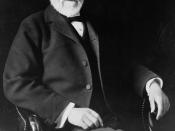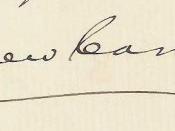In the late nineteenth century, a select few Americans separated themselves from the rest by fulfilling the American Dream. William H. Vanderbilt attained wealth as a successful railroad executive when he joined the family railroad businesses and eventually succeeded his father as president. Andrew Carnegie became one the richest people through his domination of the steel industry. John D. Rockefeller intuitive business practices in the oil industry resulted in his addition to the history books as one of the wealthiest tycoons ever. To a large extent, it was fair to characterize the industrial leaders of the late nineteenth century as either "robber barons" or "industrial statesmen" because of their harsh business practices, philanthropic efforts, and opinion of the general public that were commonly seen in men of such economic stature.
Harsh business practices often resulted in successful industrialist being labeled "robber barons" because their success entailed others failure. Competition as Andrew Carnegie saw it was a double edged sword; he said, "The price which society pays for the law of competition, like the price it pays for cheap comforts and luxuries, is also great; but the advantages of this law are also greater still."
(D. #C) John B. Weaver took note to the corruption entangled in trusts which several industrialist took advantage of. (D. #D) Mr. Weaver stated, "The main weapons of trusts are threats, intimidation, bribery, fraud, wreck, and pillage." (D. #D) Russell H. Conwell, an American Baptist Minister, the founder and first president of Temple University, and a lecturer pleaded the "industrial statesmen" label for most of the industrial rich. (D. #E) He went as far as to say, "ninety-eight out of one hundred of the rich men in America are honest. That is why they are rich." (D. #E) The illustration in document F clearly breaks down...



I really like this one.
This essay was not only informative, but easy to read. The writer kept my attention throughout the essay.
1 out of 1 people found this comment useful.